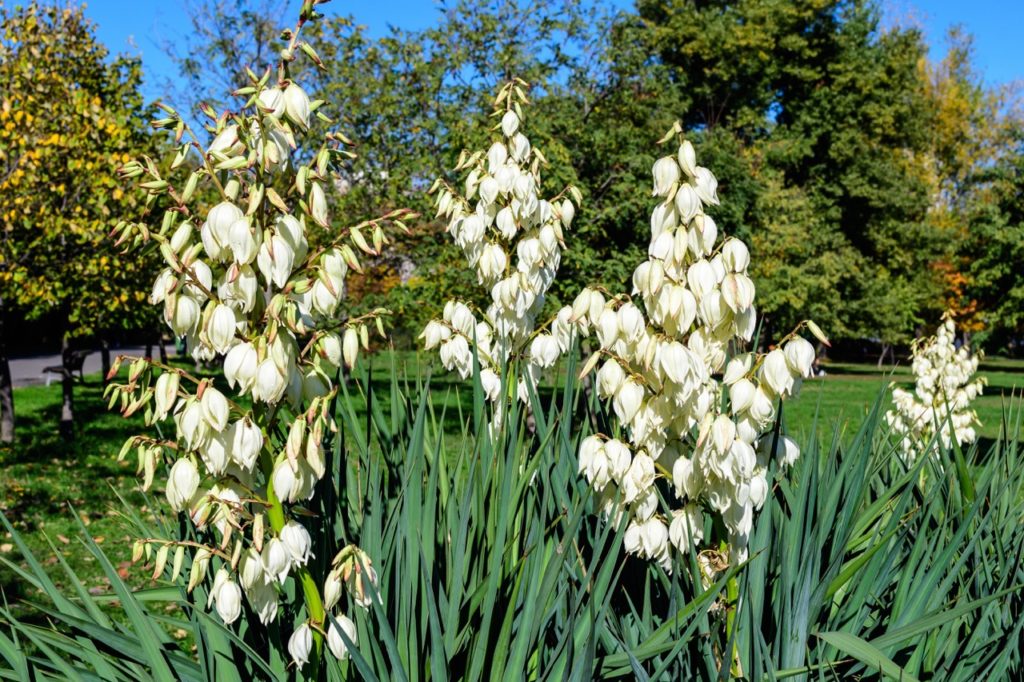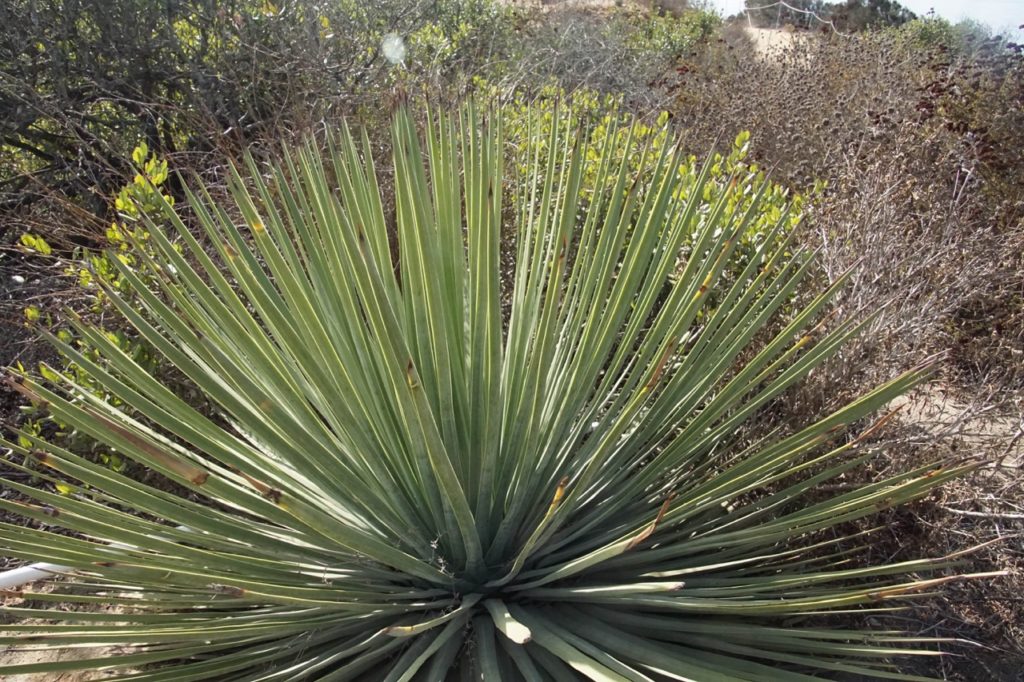8 Tender And Hardy Yucca Varieties Suited To Indoor, Patio Or Courtyard Planting

Reviewed By COLIN SKELLY

Colin is a Horticulturist and Horticultural Consultant with experience in a range of practical and managerial roles across heritage, commercial and public horticulture. He holds the Royal Horticultural Society’s Master of Horticulture award and has a particular interest in horticultural ecology and naturalistic planting for habitat and climate resilience.
IN THIS GUIDE
YUCCA GUIDES
Common Problems
– Brown Spots
– Droopy Leaves
– Leaves Turning Yellow
– Root Rot
Division
Overwintering
Revival
Varieties
Watering
With their bold, spiky foliage, bell-shaped flowers and interesting forms, yuccas will make a great addition to your displays.
Their exotic appearance recalls more tropical climes, while their stature and structure bring architectural drama to their surroundings.
A native genus of the Americas, it’s true that most yuccas do prefer warmer and drier climes.
However, many are hardy enough to withstand British weather and for those more tender species which can’t, they make excellent houseplants.
With that in mind, we’ve compiled a list of some of our favourite yucca varieties for you to cultivate in your own back garden, greenhouse or home.
When making your selection, be mindful of the effect you wish to create and the space available to you and you won’t go far wrong.
1) Y. elephantipes

- COMMON NAME(S): spineless yucca
- HARDINESS RATING: H2
- FLOWERS: white
- FLOWERING SEASON(S): summer / autumn
- SUNLIGHT: bright, direct sunlight
- EXPOSURE: sheltered
- SOIL PREFERENCE: loam or sand; any pH
- SIZE: 1.5-2m in height, 0.5-1m spread
Probably the most popular species of yucca sold in the UK, this large shrub or small tree is capable of exceeding 10m in height given the right conditions!
Unfortunately (or perhaps fortunately, depending on the dimensions at your disposal), those conditions are not common outdoors in Britain.
Therefore it makes more sense to treat spineless yuccas as houseplants.
They’re hardy down to 1°C so will do well indoors, while the fact that their leaves aren’t as spiky as many other varieties means there’s no chance of them rubbing you up the wrong way.
2) Y. gloriosa

- COMMON NAME(S): Spanish dagger
- HARDINESS RATING: H5
- FLOWERS: cream
- FLOWERING SEASON(S): summer / autumn
- SUNLIGHT: full sun
- EXPOSURE: exposed / sheltered
- SOIL PREFERENCE: chalk, loam, sand; any pH
- SIZE: 1.5-2.5m in height, 1.5-2.5m spread
At the other end of the spectrum we have the Spanish dagger, which, as the name suggests, has sharp foliage.
This is a hardy yucca suitable for borders or courtyard garden cultivation.
It’s also a large shrub or small tree, reaching around 2.5m in height, whilst its 1m long leaves and creamy flowers catch the eye when in full bloom.
Although it is suitable for growing indoors, this hardy species can do even better outside, as long as it’s placed in full sun and receives excellent drainage in its soil.

It has a slow growth rate wherever it’s cultivated, though it will mature slightly faster outside.
There is also a variegated version ‘Variegata’ with leaves striped and edged with creamish-yellow hues. Again, this is H5 hardy.
The leaves are often harvested to make rope, clothes or other materials.
3) Y. aloifolia

- COMMON NAME(S): Spanish bayonet
- HARDINESS RATING: H3
- FLOWERS: purple and white
- FLOWERING SEASON(S): summer / autumn
- SUNLIGHT: full sun
- EXPOSURE: sheltered
- SOIL PREFERENCE: chalk, loam, sand; any pH
- SIZE: 1.5-2.5m in height, 0.5-1m spread
Continuing with the theme of Hispanic pointed objects, the Spanish bayonet is equally as prickly as its compatriot.
It features one or more stems with sparse branches, crowned by a spiky rosette of razor-sharp leaves.
In summer, the blossom of white and purple-tinged flowers can stretch for over 50cm.
It’s a delicate creature that’s unable to withstand less than 7°C in the colder months.
For that reason, it’s a good idea to treat it as a houseplant or position it in your greenhouse or conservatory in winter.
4) Y. flaccida

- COMMON NAME(S): Adam’s needle / golden sword
- HARDINESS RATING: H5
- FLOWERS: white
- FLOWERING SEASON(S): summer
- SUNLIGHT: full sun
- EXPOSURE: exposed / sheltered
- SOIL PREFERENCE: loam or sand; any pH
- SIZE: 0.1-0.5m in height, 1-1.5m spread
Despite its fearsome name, the Adam’s needle yucca is far less of a weapon than the two previous entries on this list.
It’s a clump-forming shrub that dispenses with a stem altogether, instead favouring lance-like leaves.
They tend to droop away at their extremities and although not soft, they’re not as sharp as others.

Yucca flaccida such as ‘Ivory’ or ‘Golden Sword’ (both of which have received an RHS AGM) are also good choices for courtyard gardens or other sunny, relatively dry spots in the ground or in containers.
The former has white flowers on panicles around 1.5m high, while the latter has lance-like leaves with golden stripes down their centres, and creamy white flowers on panicles around 1.5m high.
Their relatively low height (just over 50cm) makes them ideal for smaller spaces, though you should be aware that both their flower panicles and their spread can exceed 1.5m.
5) Y. filamentosa

- COMMON NAME(S): needle palm
- HARDINESS RATING: H5
- FLOWERS: white
- FLOWERING SEASON(S): summer
- SUNLIGHT: full sun
- EXPOSURE: exposed / sheltered
- SOIL PREFERENCE: chalk, loam, sand; any pH
- SIZE: 0.5-1m in height, 1-1.5m spread
Easily identifiable by the thin filaments found on their long, evergreen leaves, needle palm takes both its Latin and its common name from the phenomenon.
This is a small stemless shrub which forms clumps of deep green leaves which are edges with curled filaments.
The clumps grow to around 75cm height, with a spread of around 1.5m.
In late summer, flowers are borne on panicles that can reach up to 2m in height.
While you might need to look closely to notice these defining characteristics, the tall panicles of clustered white flowers (capable of reaching over 2m in height) will be immediately obvious.
Yucca filamentosa is one of the hardier species of the genus, able to withstand temperatures as cold as -15°C.
That makes them the perfect plant for even the frostiest regions of the UK, though they still demand plentiful sunshine and adequate drainage.
This is a good choice for dry, hot borders and courtyard gardens.
“A fixture of riviera-style coastal plantings in the UK, Yucca filementosa is a great option for adding an exotic touch to your garden for all but the coldest parts of the UK,” shares Horticultural Consultant Colin Skelly.
“The stems provide year-round needle-like foliage texture and the flowers are unmissable.”
6) Y. rostrata

- COMMON NAME(S): beaked yucca
- HARDINESS RATING: H5
- FLOWERS: white
- FLOWERING SEASON(S): summer
- SUNLIGHT: full sun
- EXPOSURE: sheltered
- SOIL PREFERENCE: chalk, loam, sand; any pH
- SIZE: 2.5-4m in height, 1.5-2.5m spread
The pompom-like rosette of blue-green leaves of the beaked yucca begins life on the ground.
Don’t be fooled by its slow-moving growth habits, however; given time, this spectacular specimen can surpass 4m in height!
Its impressive stature and interesting architecture make it one of the more striking yucca plants available.
What’s more, it’s a tough customer that will fend off sub-zero temperatures with ease!
If you want it to reach its full potential, you might have a long wait on your hands, as it can take over a decade to completely mature, but the good news is that it will demand little in the way of upkeep in that time.
7) Y. whipplei

- COMMON NAME(S): our lord’s candle
- HARDINESS RATING: H4
- FLOWERS: cream
- FLOWERING SEASON(S): summer
- SUNLIGHT: full sun
- EXPOSURE: exposed / sheltered
- SOIL PREFERENCE: chalk, loam, sand; any pH
- SIZE: 0.5-1m in height, 0.5-1m spread
Our Lord’s Candle is a medium-sized shrub which features long leaves with serrated edges that take no prisoners.
Its foliage is a greenish-blue in colour and can take a decade to reach its full length of up to 5m (though normally far less), at which time it will flower.
The blooms are comprised of masses of bell-shaped white flowers which will die once it has finished blooming.
However, one or more offsets normally spring up in its place, so take care when cutting away the old plant to make way for the new.
More suitable for outdoor than indoor cultivation.
8) Y. baccata

- COMMON NAME(S): banana yucca
- HARDINESS RATING: H3
- FLOWERS: cream, red, purple and white
- FLOWERING SEASON(S): summer
- SUNLIGHT: full sun
- EXPOSURE: sheltered
- SOIL PREFERENCE: chalk, loam, sand; any pH
- SIZE: 1.5-2.5m in height, 1.5-2.5m spread
So named for its small green fruit which resembles bananas, the Yucca baccata requires next to nothing in the way of maintenance and isn’t even overly bothered about irrigation.
Its fruits are edible and incredibly sweet, often used to make cakes, tarts and other delectable desserts.1Yucca baccata. (n.d.). PFAF Plant Database. Retrieved March 27, 2023, from https://pfaf.org/user/plant.aspx?LatinName=Yucca+baccata
As for the plant itself, it’s a slow-growing shrub capable of reaching around 1.5m in height and around the same in spread, though it will take many years to do so.
It’s best suited to gravel gardens, patios or courtyard planting and should deal with the vagaries of the British climate as long as it’s afforded enough sun.
References
- 1Yucca baccata. (n.d.). PFAF Plant Database. Retrieved March 27, 2023, from https://pfaf.org/user/plant.aspx?LatinName=Yucca+baccata

